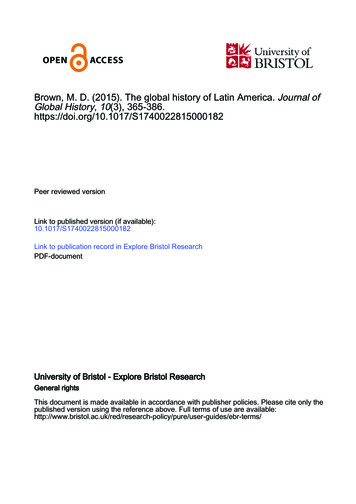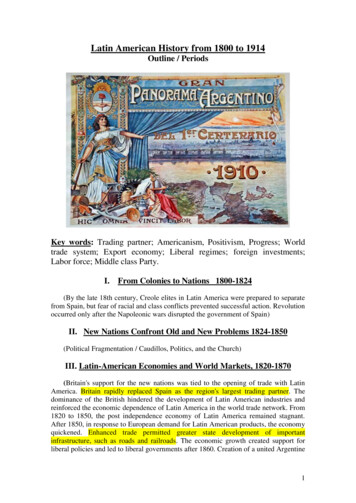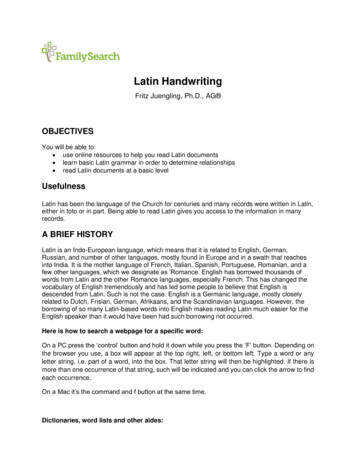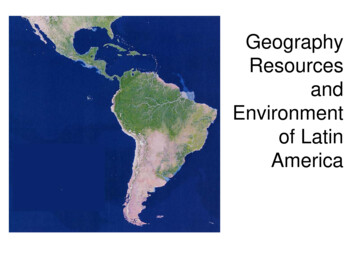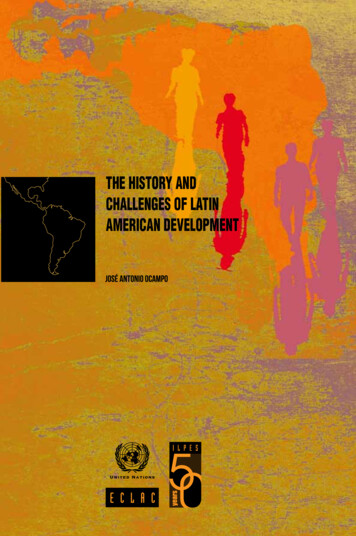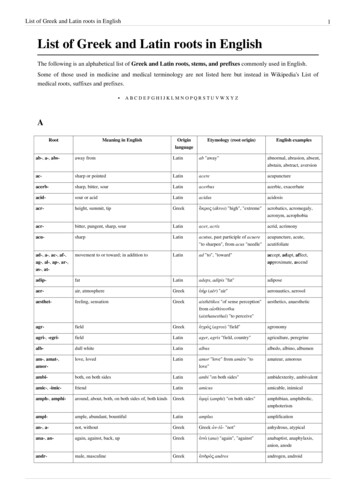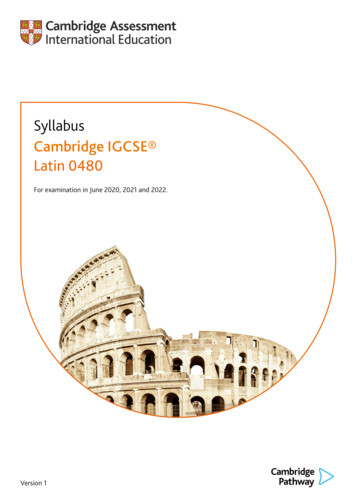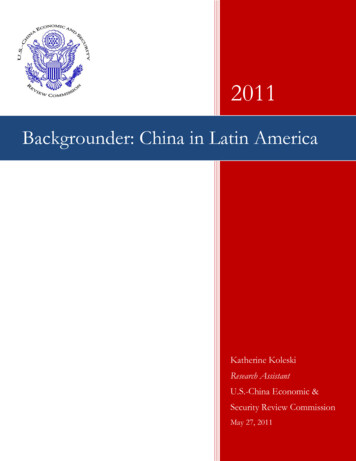
Transcription
2011Backgrounder: China in Latin AmericaKatherine KoleskiResearch AssistantU.S.-China Economic &Security Review CommissionMay 27, 2011
Disclaimer:This paper is the product of professional research performed by staff of the U.S.-ChinaEconomic and Security Review Commission. This report and its contents do not necessarilyreflect the positions or opinions of either the Commission or of its individual members, orof the Commission’s other professional staff.Backgrounder: China in Latin America2
IntroductionChina has gradually expanded its economic and political presence in Latin America 1 over the past tenyears. Though trade between China and Latin America continues to remain a relatively small share oftheir respective global trade, it is an increasing source of new economic growth for both. Resourceacquisition remains a cornerstone of Chinese trade and investment in the region. China has also sought touse investment and funding to encourage Latin American countries to officially recognize China insteadof Taiwan, thereby weakening Taiwan’s global support for a role in the international arena. In addition toinvestments, China has sought to improve its diplomatic presence through an increasing number of highlevel visits, military cooperation and exchanges, and involvement in several regional organizations.Although China is currently not a major player in the region, China’s appeal as an additional source ofinvestment and a potential new export market for Latin American goods will ensure the growth of itspolitical and economic influence in the region.ARGENTINAMap of Latin America1In this backgrounder, Latin America will refer to all countries in the Caribbean, Central America, and SouthAmerica.Backgrounder: China in Latin America3
Economic DevelopmentsIn the past ten years, trade between China and Latin America has skyrocketed due to China’s enormousdemand for new sources of natural resources and untapped markets for Chinese companies and brands.From 2000 to 2009, annual trade between China and Latin American countries grew more than 1,200percent from 10 billion to 130 billion based on United Nations statistics.2 This rapid growth has ledChina to designate Brazil, Mexico, Argentina, and Venezuela as its “strategic partners” in the region andto emerge as Latin America’s third largest trading partner. 3 Nevertheless, overall trade with Chinaremains small, roughly one-quarter of the region’s total trade with the United States, and is highlyconcentrated in resource-rich countries. 4 For more manufacturing-based economies in Latin America,particularly Central America, trade with China has been less beneficial as China begins to compete withthese countries both at home and abroad in industries such as textile manufacturing.TradeTrade between China and Latin America has increased dramatically inthe past decade, yet still remains small. China has emerged as thelargest export destination for Brazil, Chile, and Peru and the secondlargest export destination for Argentina, Costa Rica, and Cuba. 5Despite this enormous growth, only 7 percent of Latin Americanexports went to China in 2009, mainly consisting of raw materials andcommodities (see Figure 1). 6 For example, agriculture and miningsector goods composed 83 percent of Latin American exports to China,while goods from these two sectors consisted of only 33 percent of theregion’s exports to the world between 2008 and 2009.7 On the otherhand, Chinese exports to Latin America, generally industrial andmanufactured goods, comprised 5 percent of the region’s globalexports.8Soybeans from Argentinean farms representa key agricultural export to China2John Paul Rathbone, “China is now region’s biggest partner,” Financial Times, April 26, 2011.The United States is Latin America’s largest trading partner followed by the European Union. House Committeeon Foreign Affairs, Hearing on The New Challenge: China and the Western Hemisphere, testimony of Daniel P.Erikson, 110th Congress, 2nd session, June 11, 2008; and R. Evan Ellis. China in Latin America. (Boulder, Colorado:Lynne Rienner Publishers, 2009). p. 107; “Latin America and the Caribbean,” European Commission, March 21,2011. /.4In 2009, bilateral trade with the United States totaled 486 billion. John Paul Rathbone, “China is now region’sbiggest partner,” Financial Times, April 26, 2011.5Cynthia J. Arson and Jeffrey Davidow, ed. “China, Latin America, and the United States: The New Triangle,”Woodrow Wilson International Center for Scholars, January 2011.http://wilsoncenter.org/topics/pubs/LAP 120810 Triangle rpt.pdf. p. 3.6Kevin P. Gallagher, “Taking the China Challenge: China and the Future of Latin American EconomicDevelopment,” Series Brief, No. 58, December 2010. 03/Brief58 TakingChinaChallenge Gallagher.pdf. p. 2; Between 2000 and 2006, 70 percentof the economic growth of Latin America was due to the commodities export boom. Kevin Gallagher and RobertoPorzecanski, The Dragon in the Room: China and the Future of Latin American Industrialization (Palo Alto, CA:Stanford University Press, 2010). pp. 12-15.7Integration and Trade Sector, “Ten Years After the Take-off: Taking Stock of China-Latin America and theCaribbean Economic Relations,” Inter-American Development Bank, October 2010, p. 12.8Cynthia J. Arson and Jeffrey Davidow, ed. “China, Latin America, and the United States: The New Triangle,”Woodrow Wilson International Center for Scholars, January 2011.http://wilsoncenter.org/topics/pubs/LAP 120810 Triangle rpt.pdf. p. 8.3Backgrounder: China in Latin America4
Figure 1: Principal Latin American Exports and Leading Exporting Countries to China in 2008Source: Kevin Gallagher and Roberto Porzecanski, The Dragon in the Room: China and the Future of LatinAmerican Industrialization (Palo Alto, CA: Stanford University Press, 2010).Leading exports from Latin America to China include copper, iron ore, oil, and soybeans (see Table 1).Over the past two years, Chinese demand for these resources has nearly doubled, filling the drop indemand after the global financial crisis. For example, China accounts for nearly 50 percent of the growthin global iron ore exports and 58 percent of additional soybean exports.9 This rise in demand is expectedto continue with China providing a steady, increasing demand for the commodities market and raisingmarket prices. 10 According to University of East Anglia (UnitedKingdom) Professor Rhys Jenkins, Chinese demand for 15 ofApproximately 90 percentLatin America’s major export commodities has caused prices torise, leading to an estimated 42 to 75 million in revenue for theof Latin American exportsregion between 2002 and 2008.11 As a result, benefits from theto China as of 2008 wereoverall trade relationship are concentrated in a few resource-richfrom four countries: Brazilcountries.12 Approximately 90 percent of Latin American exports(41 percent), Chile (23.1to China as of 2008 were from four countries: Brazil (41 percent),Chile (23.1 percent), Argentina (15.9 percent) and Peru (9.3percent), Argentina (15.9percent). 13 Economic ties between these four countries and Chinapercent) and Peru (9.3have continued to deepen with China first becoming Chile’spercent)largest export customer in 2007 and Brazil’s largest tradingpartner in 2009.149Kevin P. Gallagher, “The China Syndrome,” Latin Trade, August 12, 2010.Kevin P. Gallagher, “China and the Future of Latin American Industrialization,” Issues in Brief, No. 18, October2010. http://www.bu.edu/pardee/files/2010/10/18-IIB.pdf. pp. 3-4.11“Researchers Analyse Changes in Latin American Middle Class and the “China Effect” on Exports,” EconomicCommission for Latin America and the Caribbean Press Release, April 19, 2011.12Mauricio Cardenas and Eduardo Levy-Yeyati, “Latin America Economic Perspectives,” The Brookings Institution,September 2010, p. 15.13Integration and Trade Sector, “Ten Years After the Take-off: Taking Stock of China-Latin America and theCaribbean Economic Relations,” Inter-American Development Bank, October 2010, pp. 7-8.14R. Evan Ellis, China in Latin America (Boulder, Colorado: Lynne Rienner Publishers, 2009) p. 25; MalcolmMoore, “China overtakes the US as Brazil’s largest trading partner,” The Telegraph, May 9, 2009.10Backgrounder: China in Latin America5
Table 1: Five Countries, Eight Sectors, Dominate LAC Trade to China (2009)SectorShare of Total Latin American Country (Share of Total Latin AmericanExports to ChinaExports to China in Sector)Copper Alloys17.9 percentChile (90 percent)Iron ore and concentrates17.3 percentBrazil (89 percent)Soybeans and other seeds16.8 percentBrazil (83 percent), Argentina (16 percent)Ores and concentrates of basemetalsCrude petroleumSoybean oil and other oils13.5 percentChile (47 percent), Peru (39 percent)4.5 percent4.5 percentBrazil (65 percent), Colombia (20 percent)Argentina (79 percent), Brazil (20 percent)Pulp and waste paperFeedstuffOtherTOTAL4.4 percent2.4 percent18.7 percent100.0 percentBrazil (55 percent), Chile (43 percent)Peru (63 percent), Chile (30 percent)Source: Kevin P. Gallagher, “China and the Future of Latin American Industrialization,” Issues in Brief, No. 18,October 2010. p. 2Although China’s demand for commodities has fueled economic growth in the region, experts haveexpressed concern regarding Latin American dependence on natural resource exports to China because ofthe inherent volatility in commodity prices and reliance on low-value added and less labor-intensiveexports. 15 Mauriciou Moreira Mesquita, a trade specialist at the Inter-American Development Bank,echoed these concerns stating, “The region is going to have to live with the fact that it is rich incommodities that are in high demand. There are obvious concerns about what happens to themanufacturing sector in that perspective.” 16 For example, 81 percent of Chile’s exports to China arecomprised of copper and copper ore, a product that has seen volatile price swings in recent years.17To mitigate the effects of changes in commodity prices, Chile and other resource-rich countries in LatinAmerica have used profits from exporting commodities to China to establish education and job trainingfunds.18 More specifically, the Chilean government used profits from copper sales to provide a stimuluspackage in response to the financial crisis. 19 However, experts from Latin American remain concernedabout China’s rising influence with Chile and other Latin American countries to pursue favorable tradepolicies and to protect its economic interests.20 For example, Argentina’s soybean industry is dependent15Exports of raw natural resources such as iron ore does not allow for firms to earn additional profit from processingthe iron ore to create steel. In addition, mining and agricultural sectors are highly mechanized with little opportunityfor new job creation in a region of high poverty and underemployment.16Matthew Kennard, “View from the US: ‘Backyard’ increases its global importance,” Financial Times, April 26,2011.17Chris Kelly and Melanie Burton, “Metals-Copper slips from record on China inflation worry,” Reuters, February15, 2011; Cynthia J. Arson and Jeffrey Davidow, ed. “China, Latin America, and the United States: The NewTriangle,” Woodrow Wilson International Center for Scholars, January 2011.http://wilsoncenter.org/topics/pubs/LAP 120810 Triangle rpt.pdf. p. 4.18Javier Santiso, “Can China change Latin America?” OECD Observer, No. 262, July 2007; Brazil, Colombia, andPeru have followed Chile’s lead and set up similar offshore funds. John Paul Rathbone, “China is now region’sbiggest partner,” Financial Times, April 26, 2011.19Kevin P. Gallagher, “China and the Future of Latin American Industrialization,” Issues in Brief, No. 18, October2010. http://www.bu.edu/pardee/files/2010/10/18-IIB.pdf. p. 7.20R. Evan Ellis, “Chinese Soft Power in Latin America: A Case Study,” National Defense University, Issue 60, 1stQuarter 2010. http://www.ndu.edu/press/lib/images/jfq-60/JFQ60 85-91 Ellis.pdf. pp. 89-90; Some experts fromLatin America that are concerned about China’s growing influence in the region include Antonio Delfim Netto,Karen Poniachik, and Rubens Ricupero. Matt Ferchen, “China-Latin America Relations: Long-term Boon or Short-Backgrounder: China in Latin America6
on Chinese demand with approximately 74 percent of Argentina’s soybean exports going to China. WhenArgentina enacted restrictions to protect domestic manufacturers in 2010, China retaliated by notapproving permits to import Argentinean soybeans, resulting in nearly 2 billion of losses.21 With Chiledependent on copper and copper ore for approximately half of its total exports in 2010 and 16.3 percent ofits global national product, a sudden drop in Chinese demand would have a significant impact on theeconomy. 22Market AccessBoth Chinese and Latin American companies have sought to enter each others’ respective markets. In aneffort to remove barriers to trade and further expand their exports, three Latin American countries havesigned free trade agreements (FTA) with China. Chile became the first Latin American country to sign aFTA with China in 2006, followed by Peru in 2010 and Costa Ricain 2011.23 Within a year of implementing the FTA with Chile, theWithin the past five years,volume of trade between Chile and China increased 100 percent,China has signed FTAsleading both countries to expand the scope of the agreement in2008. 24 Peru has also benefited from its FTA with China.with Chile, Peru, andAccording to the Inter-American Development Bank (IDB), theCosta RicaFTA has been mutually beneficial, causing Peru’s overall exports togrow 23 percent with a 48 percent increase in agricultural exportsand 65 percent increase in processed food exports. 25Chinese brands in the consumer appliance, telecommunication, and automobile industries have been ableto successfully compete in Latin American markets mainly due to their low cost appeal to price-sensitiveconsumers. For example, Chinese firms’ automobiles cost on average 15 to 30 percent less than those oftheir competitors.26 As a result, Chery, China’s largest automobile firm, has become very popular, sellingout its 2007 supply to Chile and leading to a long waiting list for its 2008 supply.27 Similarly, the sale ofterm Boom?,” The Chinese Journal of International Politics, Vol. 4., 2011. p. 69-72; Alexei Barrionuevo, “China’sInterest in Farmland Makes Brazil Uneasy,” New York Times, May 26, 2011; Karen Poniachik, “China’s BuyingSpree: Life beyond commodities,” Latin Trade, February 7, 2011.21Kevin Gallagher and Roberto Porzecanski, The Dragon in the Room: China and the Future of Latin AmericanIndustrialization (Palo Alto, CA: Stanford University Press, 2010). p. 20; William Bi, “China Said to Halt Import ofArgentine Soybean Oil,” Bloomberg, April 11, 2010; Rodrigo Orihuela, “Argentina Soybean Growers ‘Optimistic’Talk Will End China’s Oil Blockade,” Bloomberg, April 6, 2010.22Steve Anderson, “Chile’s copper dependency has taken a turn for the worse: 55% of all exports,” MecroPress.November 16, 2010.23Javier Santiso, “Can China change Latin America?” OECD Observer, July 2007, No. 262; Shayne Heffernan,“IDB and China’s Eximbank Sign Deal to Boost China-Latin,” Live Trading News, October 25, 2010; Integrationand Trade Sector, “Ten Years After the Take-off: Taking Stock of China-Latin America and the CaribbeanEconomic Relations,” Inter-American Development Bank, October 2010, p. 16.24R. Evan Ellis, China in Latin America (Boulder, Colorado: Lynne Rienner Publishers, 2009) p. 42.25Integration and Trade Sector, “Ten Years After the Take-off: Taking Stock of China-Latin America and theCaribbean Economic Relations,” Inter-American Development Bank, October 2010, p. 16.26In 2010, Chinese automobile manufacturers controlled 7 percent of the Chilean and 4 percent of the Peruvianautomobile market. According to the Economist Intelligence Unit, the market share of Chinese vehicle exports toChile rose sharply to 5.5 percent in 2008 but then stabilized in 2009. R. Evan Ellis, China in Latin America (Boulder,Colorado: Lynne Rienner Publishers, 2009) p. 38.; “Peru: Automobile Market Outlook,” BBVA Research, mobile market outlook peru tcm348-239550.pdf?ts 2222011 p.11.; Economist Intelligence Unit, “Chile: Automotive Report,” August 4, 2010.http://www.eiu.com/index.asp?layout ib3Article&article id 827322267&country id 1500000150&pubtypeid 1112462496&industry id &category id .27In 2010, Chery experienced significant growth in 2008 after the enactment of the China-Chile FTA to gain 1.3percent of Chile’s light automobile vehicle market share, but it failed to further expand in 2009. R. Evan Ellis, ChinaBackgrounder: China in Latin America7
Chinese motorcycles from 2003 to 2007 in Chile increased 1,650 percent due to their costcompetitiveness, with Chinese firms dominating approximately 75 percent of the Chilean motorcyclemarket. 28 Chinese firms are aggressively competing to establish themselves as a household brand forLatin America’s emerging middle-class consumer market.Latin American mining, oil, and agricultural industries have successfully exported to China, butmanufacturing industries such as textiles, footwear, and furniture have been less successful due to globaland domestic competition with Chinese firms. 29 According to Kevin Gallagher, Associate Professor ofInternational Relations at Boston University, 92 percent of Latin American companies faced competitionfrom Chinese firms in 2009. The rise in imports of Chinese manufactured goods has begun to impactLatin American firms. The U.N. Economic Commission for Latin America and the Caribbean estimatesthat 60 percent of anti-dumping complaints initiated by Latin American countries are against China.30 Asa result of competition between Chinese and Latin American manufacturing companies, there has beenbacklash by local businesses in Mexico, Brazil, Argentina, and Colombia against local Chinese businesscompetitors and the influx of Chinese made products.31Brazil’s Growing Trade Relationship with ChinaBrazil is one of China’s largest trading partners in the region. From 1998 to 2008, trade between the twocountries increased 1,838 percent. 32 This rapid growth in trade and investment has fueled Brazil’seconomy and provided needed demand in a slumping global market.33 However, similar to the rest of theregion, Brazil exports mainly raw commodities and imports manufactured products from China. In 2009,77 percent of Brazil’s exports to China consisted of raw materials and commodities while industrialproducts were only 23 percent. Of Brazil’s total exports to China, iron ore accounted for approximately40 percent and soy beans and soy oil accounted for an estimated 23 percent. 34 In contrast, Brazil’simports from China are 98 percent industrial products.35While these exports have led to further economic growth in Brazil and improved quality of life byproviding low-cost products, competition in manufacturing sectors has led to the outsourcing of factoriesin Latin America (Boulder, Colorado: Lynne Rienner Publishers, 2009) p. 39; “Latin America: Automobile MarketOutlook,” BBVA Research, December mult/INTAULT 14122010 tcm348-239499.pdf?ts 2222011 p. 7.;Economist Intelligence Unit, “Chile: Automotive Report,” August 4, 2010.http://www.eiu.com/index.asp?layout ib3Article&article id 827322267&country id 1500000150&pubtypeid 1112462496&industry id &category id .28R. Evan Ellis, China in Latin America (Boulder, Colorado: Lynne Rienner Publishers, 2009) p. 39.29Integration and Trade Sector, “Ten Years After the Take-off: Taking Stock of China-Latin America and theCaribbean Economic Relations,” Inter-American Development Bank, October 2010, p. 1.30Cynthia J. Arson and Jeffrey Davidow, ed. “China, Latin America, and the United States: The New Triangle,”Woodrow Wilson International Center for Scholars, January 2011.http://wilsoncenter.org/topics/pubs/LAP 120810 Triangle rpt.pdf. p. 4.31Integration and Trade Sector, “Ten Years After the Take-off: Taking Stock of China-Latin America and theCaribbean Economic Relations,” Inter-American Development Bank, October 2010, p. 18.32Expo 2010 Brasil, “China and Brazil strengthen trade relations,” Press Release, March 24, 33For example, China was the largest single source of foreign direct investment for Brazil in 2010 with 15 percentof the total followed by Switzerland with 13 percent and the United States with 11 percent. Economic Commissionfor Latin America and the Caribbean, “Foreign Direct Investment in Latin America and the Caribbean, 2010,”United Nations, May 2011. 1-138-LIEI 2010WEB INGLES.pdf. p. 41.34Brian Winter and Brian Ellsworth, “Brazil and China: A young marriage on the rocks,” Reuters, February 3, 2011.35Expo 2010 Brasil, “China and Brazil strengthen trade relations,” March 24, Backgrounder: China in Latin America8
to China or an inability of domestic firms to compete with the lower prices of Chinese firms. 36 Accordingto a study of 1,529 firms conducted by Brazil’s National Industrial Confederation, one-fourth of Brazilianmanufacturers face competition from Chinese firms in the domestic market, and two-thirds of Brazilianexporters have lost foreign clients to China.37 The Federation of Industries of the State of Sao Pauloestimates that this competition with China has led to the loss of approximately 70,000 Brazilianmanufacturing jobs in 2010 and 10 billion in expected earnings for local industry.38As these two countries compete in the same manufacturing sectors, the results of this competition haveled to some recent political tensions. For example, in statements with union leaders, Brazilian PresidentRousseff stated that “There is a misbalance in our relations with China. Brazil exports commodities andimports too many knick-knacks. This happens particularly between Christmas and Carnival. I’m toldthat 80 percent of this year’s [2011] Carnival costumes came from China.”39Foreign Direct Investment (FDI)China is also becoming a new source of FDI in the world as the world’s fifth largest investor country. 40Since 2003, China has increased its global outward FDI flows 1,880 percent to 56.5 billion in 2009.According to the Chinese government’s 2009 Statistical Bulletin of China’s Outward Foreign DirectInvestment, only 13 percent of this outward FDI is in Latin America, whereas nearly three-fourths is inAsia. Of the 7.33 billion in Chinese FDI for Latin America in 2009, the Cayman Islands and BritishVirgin Islands received 73 percent and 22 percent respectively.41 A majority of the money invested inthese two financial tax havens is sent to take advantage of tax breaks for “foreign companies” and is thenreinvested in China.42 For a more accurate view of FDI in the region, these two countries’ figures will beexcluded.Excluding the Cayman Islands and British Virgin Islands, Chinese FDI to the region increasedapproximately 1,500 percent from US 21.86 million in 2003 to US 349.55 million in 2009, becoming theregion’s third largest FDI provider. 43 The largest recipients of Chinese FDI parallel China’s mostimportant trading partners in the region: the leading recipients of Chinese FDI from 2003 to the firstsemester of 2010 were Brazil (41 percent), Venezuela (15 percent), Peru (12 percent), Argentina (1136For example, the Brazil-China Business Council estimated that Brazil lost 90 percent of its share of the U.S. shoemarket to Chinese competition in 2008. Julie McCarthy, “Growing Trade Ties China to Latin America,” NationalPublic Radio, April 1, 2008.37Iuri Dantas, “Brazil Will Work With Obama to Counter Rising China Imports, Official Says,” Bloomberg,February 3, 2011.38Joe Leahy, “Brazilian factories tested by Chinese imports,” Financial Times, January 30, 2011.39“Brazil’s Plan to Cut Chinese Imports & Stimulate Industry,” Merco Press, March 14, 2011.40For a breakdown on Chinese FDI worldwide see: Nargiza Salidjanova, “Going Out: An Overview of China’sOutward Foreign Direct Investment,” U.S.-China Economic & Security Review Commission, March 30, Out.pdf; Economic Commission for Latin America and theCaribbean, “Foreign Direct Investment in Latin America and the Caribbean, 2010,” United Nations, May 0/2011-138-LIEI 2010-WEB INGLES.pdf. p. 17.41Ministry of Commerce of the People’s Republic of China, 2009 Statistical Bulletin of China’s Outward ForeignDirect Investment, (Beijing, China: 2009).42Thomas Lum, Hannah Fischer, Julissa Gomez-Granger, and Anne Leland, “China’s Foreign Aid Activities inAfrica, Latin America, and Southeast Asia,” Congressional Research Service, February 25, 2009, p. 13.43Ministry of Commerce of the People’s Republic of China, 2009 Statistical Bulletin of China’s Outward ForeignDirect Investment, (Beijing, China: 2009); The United States is the region’s largest investor with 17 percent of totalFDI to the region followed by the Netherlands at 13 percent and China at 9 percent. Economic Commission forLatin America and the Caribbean, “Foreign Direct Investment in Latin America and the Caribbean, 2010,” UnitedNations, May 2011. 1-138-LIEI 2010-WEB INGLES.pdf. p. 9.Backgrounder: China in Latin America9
percent), and Chile (2 percent). 44 However, Chinese FDI composes a relatively small portion of total FDIto the region with the United States investing approximately 142 billion in the region last year bycomparison. 45 Despite the small relative share, the rapid growth of China’s global outward FDI hasattracted the attention of many Latin American governments and businesses as an alternative source ofinvestment to fuel economic growth and fund infrastructure and resource projects. 46Chinese FDI in the region has focused on three key objectives:resource acquisition, market access, and efficiency seeking. 47Natural resource extractionRecent projects in the region have focused largely on resourceacquisition (See Table 2). According to the United Nationscomposed 90 percent ofEconomic Commission for Latin America and the Caribbean,Chinese investment in the90 percent of China’s investment in the region has gone toregionnatural resource extraction. 48 In 2010 alone, China spent 13.3billion on oil and gas deals in countries such as Ecuador,Argentina, and Venezuela. 49 Moreover, some Chinesecompanies have been able to win contracts in Latin America through their ability to secure additionalfunding from the Chinese banks. For example, the ability of the Chinese company SinoHidro to selffinance 85 percent of the construction of the Coco Coda Sinclair Hydroelectric plant through loans withChinese banks assisted the Chinese company in bypassing the local partner requirement and securing a 1.7 billion loan deal with the Ecuadorian government. 50 Although Chinese investment has providedcritically needed infrastructure for the region, many Latin America governments would like to see morediversification of Chinese investment to other sectors besides mining and agriculture to ensure long-termeconomic development.51 In addition, the rise of China as an alternative source of financing for projectshas raised concerns about the ability of the United States and Europe to encourage progress on humanrights and/or environmental protection issues with countries such as Venezuela.5244Integration and Trade Sector, “Ten Years After the Take-off: Taking Stock of China-Latin America and theCaribbean Economic Relations,” Inter-American Development Bank, October 2010, p. 26.45For example, the United States foreign direct investment totaled 57 billion in Brazil and 23 billion in Chile bythe end of 2009. White House Press Office, “Fact Sheet on the U.S. Relationship with Central and South America:An Emerging Partnership for Economic Growth,” (Washington, DC: March 15, 2011).46Simon Romero and Alexei Barrionuevo, “Deals Help China Expand Sway in Latin America,” The New YorkTimes, April 15, 2009.47Efficiency-seeking FDI is investing in foreign markets to take advantage of a lower cost structure.48Economic Commission for Latin America and the Caribbean, “Foreign Direct Investment in Latin America andthe Caribbean, 2010,” United Nations, May 2011. 1-138LIEI 2010-WEB INGLES.pdf. p. 18; In February 2011, China indicated that it would like to derive 40 percent ofiron ore imports Chinese-invested sources by 2015. To meet this goal, China may start investing more in iron oremining operation in Brazil, Venezuela, Chile, and Peru. Chuin-Wei Yap, “China Plans Overseas Iron Ore AssetSpree,” The Wall Street Journal, February 23, 2011.49Jim Bai and Farah Master, “China’s Sinopec buys Occidental Argentine assets,” Reuters, December 10, 2010.50R. Evan Ellis, “Chinese Soft Power in Latin America: A Case Study,” National Defense University, Issue 60, 1stQuarter 2010. http://www.ndu.edu/press/lib/images/jfq-60/JFQ60 85-91 Ellis.pdf. pp. 89-90.51Integration and Trade Sector, “Ten Years After the Take-off: Taking Stock of China-Latin America and theCaribbean Economic Relations,” Inter-American Development Bank, October 2010, pp. 29-30.52Cynthia J. Arson and Jeffrey Davidow, ed. “China, Latin America, and the United States: The New Triangle,”Woodrow Wilson International Center for Scholars, January 2011.http://wilsoncenter.org/topics/pubs/LAP 120810 Triangle rpt.pdf. p. 5.Backgrounder: China in Latin America
Commission for Latin America and the Caribbean Press Release, April 19, 2011. 12 Mauricio Cardenas and Eduardo Levy-Yeyati, Latin America Economic Perspectives, The Brookings Institution, September 2010, p. 15. 13Integration and Trade Sector, Ten Years After the Take -off: Taking Stock of China Latin America and the
